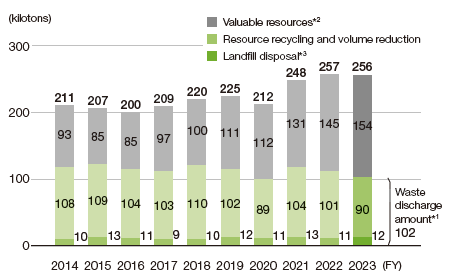Working towards a Recycling-based Society
As a result of being a mass-production, mass-consumption, and mass-disposal society, we now face many problems such as the depletion of resources and increasing waste. The increase in plastic waste has led to marine plastic pollution in the worldʼs oceans—now a serious problem for society.
The Kubota Group sees working towards a recycling-based society as one of its materiality, and has been advancing initiatives to promote “reduce” (reducing the amount generated), “reuse” (internal recycling and reuse), and “recycle” (improving the recycling ratio) of waste, in addition to initiatives to promote the effective use of resources and resource saving.
- Activities towards achieving SDGs
- Medium-Term Environmental Conservation Targets and the Results
- Waste, etc. from Business Sites
- Improvement of Resource Efficiency
- Handling and Storage of Equipment Containing PCB (in Japan)
Activities towards achieving SDGs
| Related SDGs and targets |
 |
|---|---|
| Major Activity Content |
|
| 2025 Activity Targets (KPIs) |
|
Medium-Term Environmental Conservation Targets and the Results
| Action item | Management indicator*1 | Base FY | Target for FY2025*4 | New Target for FY2030*4 | Result of FY2023 |
|---|---|---|---|---|---|
| Reduce waste | Waste discharge per unit of production |
2014 | ▲45% | ▲50% | ▲49.7% |
| Hazardous waste discharge per unit of production*2 | 2019 | ▲17% | - | ▲11.6% | |
| Recycling ratio (Japan)*3 | - | Maintain 99.5% or more |
- | 99.6% | |
| Recycling ratio (Overseas)*3 | - | Maintain 90.0% or more |
- | 94.9% |
- *1.The figures per unit of production represent the intensity of the environmental load per unit of money amount of production. The exchange rate of the FY2014 is used when translating the money amount of production of overseas sites into Japanese yen.
- *2.Industrial waste defined as hazardous by legislation in each country.
- *3.Recycling ratio (%) = (Sales amount of valuable resources + External recycling amount) / (Sales amount of valuable resources + External recycling amount + Landfill disposal) × 100. Heat recovery is included in the external recycling amount.
- *4.▲ indicates a negative figure.
Waste, etc. from Business Sites
1. Waste, etc. discharge
In FY2023, the waste discharge amount was 102 kilotons, a decrease of 9.0% compared to the previous year. Also, waste discharge per unit of sales improved by 19.4% year on year. The amount of waste discharge decreased due to decline in production volume at casting production sites and the conversion of waste wood as valuables, despite an increase due to building replacement work at overseas machinery sites. Waste discharge per unit of sales improved as consolidated net sales increased (up 12.8% from the previous year).
Of the waste discharge amount in FY2023, the amount of hazardous waste discharge was 7.1 kilotons, up 12.8% from the previous year.
-
Trends in Waste, Etc. (including valuable resources) and Waste Discharge per Unit of Sales
- *1. Waste discharge = Resource recycling and Volume reduction + Landfill disposal
- *2.To reduce overall emissions to the outside of the Group, including valuable resources, metal scraps generated at machinery production and related sites are collected for recycling at cast iron production sites within the Group. From FY2019, as a way of evaluating the progress of these activities, calculation standards have been changed so that transfer of valuable resources between business sites within the Group is no longer included in the valuable resources figure, but is counted instead as in-house recycling and reuse.
- *3.Landfill disposal = Direct landfill disposal + Final landfill disposal following external intermediate treatment
- *4.Waste discharge per unit of consolidated net sales. The Kubota Group adopted International Financial Reporting Standards (IFRS) instead of accounting principles generally accepted in the United States of America from FY2018.
2. Measures to Reduce Waste
The Kubota Group has established the Medium-Term Environmental Conservation Targets and is working to reduce the emissions of waste and hazardous waste and increase the resource recycling ratio at production sites. The Group has been promoting various measures, such as ensuring that waste is separated properly according to type and disposal method, switching to returnable packaging materials and recovering valuable resources, and utilizing recycled materials at sites. The Group is continuing to reduce the volume of sludge, waste oil, and oily wastewater generated from painting processes (by changing pre-treatments), as well as waste plastic generated from plastic molding processes. Meanwhile, as measures to reduce disposable plastics, we introduced initiatives at certain worksites to withdraw the use of disposable tableware in the employee cafeteria and reduce the issue of plastic shopping bags in on-site stores.
As a result of the efforts toward achieving the Medium-Term Environmental Conservation Targets 2025 for waste reduction, global production sites achieved a reduction of 1,500 tons of waste in FY2023 compared with the case where countermeasures were not implemented from the previous year. The economic effects of these measures reached 17 million yen. Waste discharge per unit of production in FY2023 improved by 49.7% compared to the base year (FY2014). The recycling ratio was 99.6% at production sites in Japan and 94.9% at production sites overseas.
Moreover, production sites in Japan have raised the utilization rate of electronic manifests to 98.1%, enabling real-time assessment of the reduction effects. We will continue to promote the reduction of waste through encouraging sharing of good reduction practices and visualization of waste by utilizing electronic manifests.
-

At the Kubota Sakai Plant, some of the wooden boxes and pallets used for test components imported from our Group company in China have been swapped for reinforced cardboard, helping to reduce wood scraps. Furthermore, we are taking steps to introduce reusable plastic pallets and to make wooden pallets returnable.
Examples of Collaboration with Other Companies
At Kubota Baumaschinen GmbH in Germany, the use of reusable containers is being trialed in collaboration with suppliers in order to reduce packaging waste. The volume of waste derived from packaging materials brought into the factory amounts to 755 tons annually. The materials used in packaging include cushioning materials, cardboard, and adhesive tape. The use of reusable containers will not only mean the company can cut down on waste, but it also benefits suppliers by enabling them to reduce the materials needed for deliveries.
-
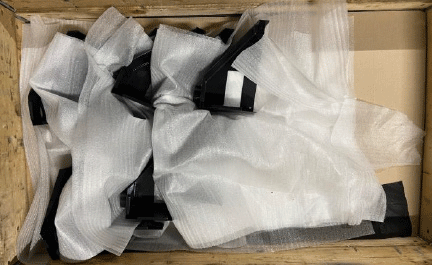
(Before) Construction machinery parts delivered to the factory
-
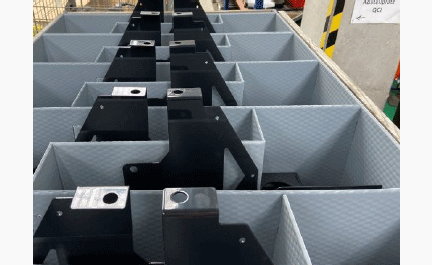
(After) Parts housed in reusable containers
-
Waste Recycling and Treatment Flow (FY2023 results)
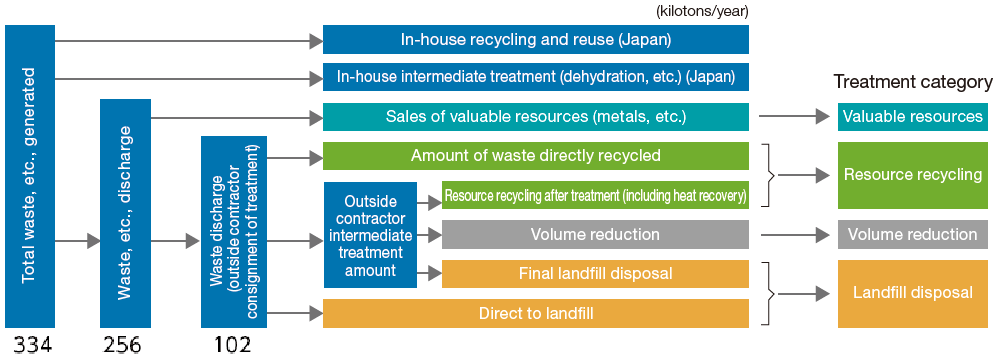
-
Waste Discharge by Region
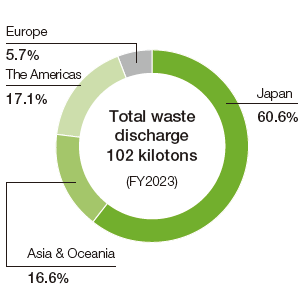
-
Waste Discharge by Business
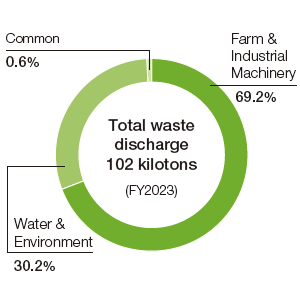
-
Waste Discharge by Type
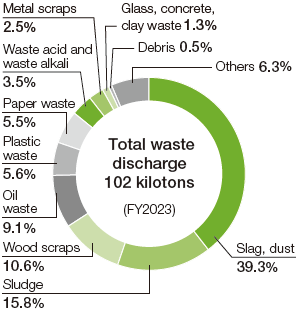
-
Waste, Etc. Discharge by Treatment Category
-
Japan
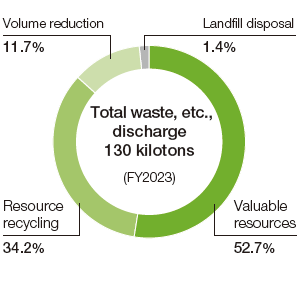
-
Overseas
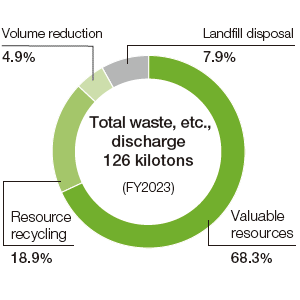
-
Please follow the link below for waste discharge amounts at each production site.
www.kubota.com/sustainability/environment/report/2024/sitereport.html
3. Trends in Recycling Ratio
The recycling ratio in FY2023 was 98.4% in Japan, an improvement of 0.3 points from the previous year, but overseas decreased by 0.7 points to 91.7%. Globally, it decreased 0.3 points to 95.0%. We will make continuous efforts to improve the resource recycling ratio.
-
Trends in Recycling Ratio

- *1.Recycling ratio (%) = (Sales amount of valuable resources + External recycling amount) / (Sales amount of valuable resources + External recycling amount + Landfill disposal) × 100.
External recycling amount includes heat recovery
- *1.Recycling ratio (%) = (Sales amount of valuable resources + External recycling amount) / (Sales amount of valuable resources + External recycling amount + Landfill disposal) × 100.
Improvement of Resource Efficiency
As the global population continues to increase and economic development progresses, resource consumption is expected to increase as well. Moreover, in recent years, marine plastic pollution has become a global problem, as used plastic flows onto beaches and into the sea via rivers and so forth. The Kubota Group has been contributing to the formation of a recycling-based society by promoting improvement of waste discharge per unit of production and increases in the recycling ratio at its global production sites in the Medium-Term Environmental Conservation Targets 2025. In tandem with this, we have also set new targets for the 3Rs (Reduce, Reuse, and Recycle) of waste plastic generated by business activities, and reduction of packaging and paper resource use.
The Kubota Group will continue to improve resource efficiency through initiatives such as effective use of resources throughout the entire business value chain and reduction of waste.
-
■ Reducing Plastic Waste
Based on the Medium-Term Environmental Conservation Targets 2025, we are reducing plastic use in our business sites, with a particular focus on single-use plastics. We are promoting efforts to reduce the use of plastic containers in cafeterias, plastic shopping bags at on-site stores, and PET bottle waste by encouraging people to bring reusable bottles.

At Kubota Agricultural Machinery (Suzhou) Co., Ltd. (China), we ran an initiative to swap individually packaged drinks for fruit during environment month in June in a bid to reduce plastic trash.
-
■ Reducing Resource Usage in Packaging and Adopting Returnable Packaging
Based on the Medium-Term Environmental Conservation Targets 2025, we are collaborating with our business partners to reduce resource use in packaging materials and encourage adoption of returnable packaging in an effort to reduce waste discharge. At our business sites, we are promoting the replacement of stretch film and wooden pallets used for packaging components and so forth with reusable containers and packaging materials.

At Kubota Precision Machinery (Thailand) Co., Ltd., we reviewed our use of single-use cardboard and plastic film packaging in an effort to reduce waste and conserve labor resources.
■ Transition to Paperless Operations
Under our Medium-Term Environmental Conservation Targets 2025, we are taking steps to transition to paperless operations with the goals of increasing operational efficiency and reducing environmental impacts. As workstyles shift from office work to telework (working from home) due to the COVID-19 pandemic, we promoted adoption of electronic systems for internal request approvals and determinations, and a reduction in documents stored in paper format. Moreover, we were also promoting effective use of office space and online meetings, enabling us to reduce the use of paper printouts. At our production sites, we have also made progress on switching to electronic check sheets and forms.
Handling and Storage of Equipment Containing PCB (in Japan)
Transformers, capacitors and other equipment containing polychlorinated biphenyls (PCB) are properly reported, stored and handled based on the Japanese Act on Special Measures concerning Promotion of Proper Treatment of PCB Wastes, and the Japanese Waste Management and Public Cleansing Law. Waste with a high concentration of PCB is being disposed of steadily, beginning with sites where PCB-treatment facilities are available. Waste with a low concentration of PCB will be properly disposed of by the disposal deadline of March 2027.
PCB-containing equipment in storage is thoroughly managed by multiple means, such as the locking of storage cabinets, periodic inspection, and environmental audits.
